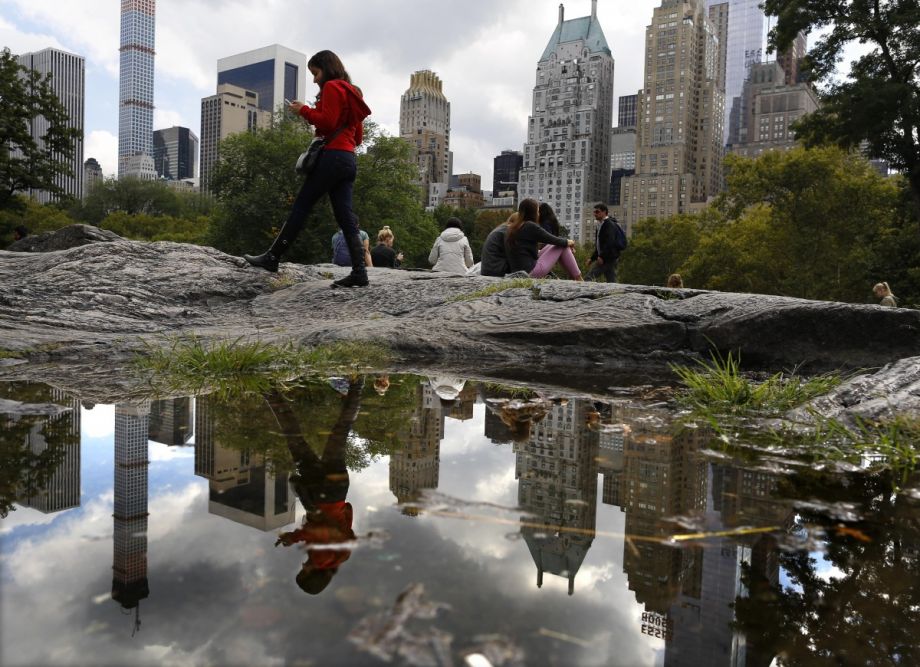Parklets Are Great, But Big Parks Pack a Big Punch

(AP Photo/Julie Jacobson)
Is there a right way to green a city? Yes, University of Exeter researchers say, planning high-density neighborhoods with grand parks, as opposed to low-density neighborhoods with ample lawns and smaller public spaces, is significantly better for a city’s ecosystem and residents.
In times of rapid urbanization, the Exeter-based authorsof a new study in September’s Frontiers in Ecology and the Environment argue that setting aside larger parkland, or “land sparing,” is key for environmental stability globally. (The latest U.N. forecast estimates that two-thirds of world’s population will live in cities by 2050; more than half of the current population already does.)
“There are a lot of studies that show that gardens are good for ecosystems, nature and biodiversity, and that is absolutely true,” says Iain Stott, one of the authors. “But the key point here is: If you don’t include large contiguous green spaces, then you’re probably not going to be providing a., as high as amount of ecosystem services as you could, and b., as many ecosystem services as you could.”
An ecosystem service is an ecological benefit, like whether it can support robust foodways, or has favorable conditions for flood management or inspires fond connections to local heritage through its terrain.
The researchers examined landscapes in nine cities. The services they homed in on in were: carbon storage (both aboveground and below), water infiltration, human well-being, agricultural production, pollination, pest control, noise reduction, air purification and temperature regulation. The results of their analysis found that land sparing produced more gains in almost every category.
Now, you may be wondering how something like noise reduction potential would be greater in a dense urban environment. This is because the data accounts for how sound disperses in the parklands as well. Quite basically, it’s a case of: “If a tree falls in the forest, does it make a sound?” These larger nature preserves similarly swayed the results for evenness of temperature and air quality.
This, Stott says, is a big reason why smaller green spaces and street trees remain crucial.
“If you can plant trees on the street, and have other green infrastructure in the urban areas, it’s actually quite important to do so,” says Stott.
The positive effects of nearby green space on physical and mental health make an excellent case for incorporating smaller parks too. Health was a category where land sparing actually fell short, researchers found.
The exact ecological mechanisms that make land sparing more successful in the other focus areas need more study. Some basic things are knowable though. In the way that more bees could fly more from to flower to flower in a trail, residents who are able to walk, bike and share transit as they commute could leave behind lighter carbon footprints, and a wider range of food could be cultivated in an expanse, just to give a few examples.
The findings suggest that there is something about sprawl that frustrates the delicate connectivity in an ecosystem between organisms that neighbor one another. And while sparser development is frequently labeled “suburban,” low-density neighborhoods are extremely common in cities too. According to Alan Mallach, a senior fellow at the Center for Community Progress, dense urbanist dreamscapes are more so “pockets” in American cities, with the exception of places like San Francisco and New York. (For a more global perspective, consider this 2011 report, a number-crunch of 326 studies on urban development. It revealed that “[a]cross all regions and for all three decades [of analysis], urban land expansion rates are higher than or equal to urban population growth rates, suggesting that urban growth is becoming more expansive than compact.”)
Cities aren’t inherently dangerous for the environment; poorly planned urban development is.
Stott says their study takes a side on what that means. “In this long-running debate about compact versus sprawling development,” he says, “this is just a way of taking that old debate, and explicitly including green space as a part of that.”

Cassie Owens is a regular contributor to Next City. Her writing has also appeared at CNN.com, Philadelphia City Paper and other publications.

No comments:
Post a Comment
Please leave a comment-- or suggestions, particularly of topics and places you'd like to see covered